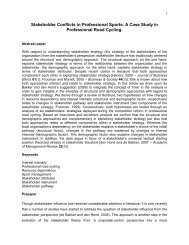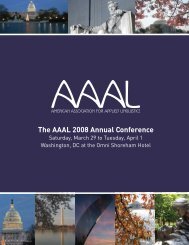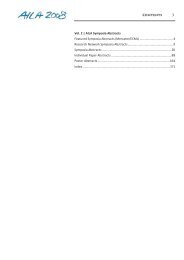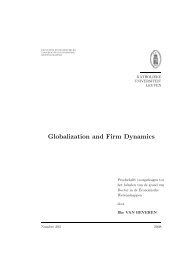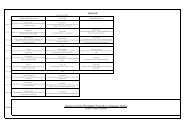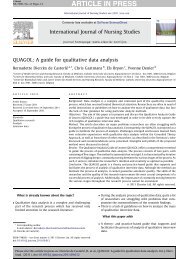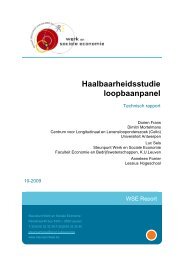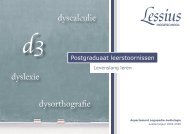The role of implicit attitudes towards food and ... - ResearchGate
The role of implicit attitudes towards food and ... - ResearchGate
The role of implicit attitudes towards food and ... - ResearchGate
Create successful ePaper yourself
Turn your PDF publications into a flip-book with our unique Google optimized e-Paper software.
42 M. Craeynest et al. / Eating Behaviors 9 (2008) 41–51<br />
research is necessary to investigate whether the underlying dynamics <strong>of</strong> the <strong>food</strong> <strong>and</strong> physical activity behaviour are<br />
affected by the treatment, <strong>and</strong> to what extent their change is related to weight loss <strong>and</strong> weight regain.<br />
Several characteristics have been found to be important predictors <strong>of</strong> weight loss in obese youngsters following<br />
treatment, under which baseline degree <strong>of</strong> overweight <strong>and</strong> the child's age (Braet, 2006). Further, an amount <strong>of</strong> theories<br />
have dealt with possible explaining psychological determinants, such as the learning history <strong>of</strong> the child <strong>and</strong> a<br />
heightened responsiveness to <strong>food</strong> cues (for a review, see Braet, 2005). From a healthy psychology perspective,<br />
<strong>attitudes</strong> <strong>towards</strong> <strong>food</strong> <strong>and</strong> exercise have been put forward as crucial factors in the development <strong>and</strong> maintenance <strong>of</strong><br />
obesity (e.g., De Bourdeaudhuij et al., 2005; Dennison & Shepherd, 1995).<br />
In most studies, <strong>attitudes</strong> are asked directly, for instance using self-reports. Recently, however, it has been argued<br />
that their indirect assessment, by which cognitions are inferred from behaviour performance other than self-report,<br />
should have a better explanatory <strong>and</strong> predictive value because <strong>of</strong> two reasons (Greenwald et al., 2002). First, indirect<br />
measures should be more resistant for dem<strong>and</strong> characteristics that <strong>of</strong>ten affect self-reports (see Schwarz, 1999). Second,<br />
indirect measures are supposed to catch cognitive automatic associations that guide spontaneous behaviour, <strong>and</strong> that<br />
can not easily be tapped by self-reports. <strong>The</strong> outcome <strong>of</strong> the indirect assessment <strong>of</strong> these associations is <strong>of</strong>ten called<br />
<strong>implicit</strong> cognitions. Implicit <strong>attitudes</strong> then are the measure <strong>of</strong> automatic associations between an attitude object <strong>and</strong> a<br />
certain valence (Greenwald et al., 2002).<br />
In the last decades, several indirect response time based paradigms have been constructed to assess <strong>implicit</strong> <strong>attitudes</strong><br />
(for a review, see Fazio & Olson, 2003), amongst which the affective priming task (Fazio, Sanbonmatsu, Powell, &<br />
Kardes, 1986), the Implicit Association Task (IAT; Greenwald, McGhee, & Schwartz, 1998) <strong>and</strong> the Extrinsic<br />
Affective Simon Task (EAST; De Houwer, 2003). <strong>The</strong> core principle <strong>of</strong> these tasks is that <strong>implicit</strong> <strong>attitudes</strong> are inferred<br />
from the reaction time (<strong>and</strong> percentage <strong>of</strong> errors) performance on a computer sorting task. More specifically, it is<br />
assumed that response latencies will be shorter (<strong>and</strong> less errors will be made) when participants have to use the same<br />
response bottom to sort stimuli that carry the same valence (congruent stimuli; e.g., names <strong>of</strong> insects <strong>and</strong> negative<br />
nouns vs. names <strong>of</strong> flowers <strong>and</strong> positive nouns), than when the same response bottom has to be pressed for stimuli with<br />
an opposite valence (incongruent stimuli; e.g., names <strong>of</strong> insects <strong>and</strong> positive nouns vs. names <strong>of</strong> flowers <strong>and</strong> negative<br />
nouns). Implicit <strong>attitudes</strong> are calculated then by comparing the performance on the congruent stimuli with the<br />
performance on the incongruent stimuli.<br />
Indirect measures have been applied in several domains <strong>of</strong> clinical <strong>and</strong> health psychology (for a review, see Fazio &<br />
Olson, 2003). As described elsewhere (Craeynest et al., 2005), we used the EAST in a cross-sectional study<br />
investigating <strong>implicit</strong> <strong>food</strong> <strong>and</strong> exercise <strong>attitudes</strong> in children <strong>and</strong> adolescents with obesity at the beginning <strong>of</strong> an<br />
intensive treatment. Our results revealed a borderline significant effect, indicating that youngsters with obesity<br />
<strong>implicit</strong>ly preferred both unhealthy <strong>and</strong> healthy <strong>food</strong>, whereas normal-weight controls evaluated them as neutral. No<br />
effects were found for physical activity.<br />
Longitudinal research investigating whether <strong>implicit</strong> <strong>food</strong> <strong>and</strong> physical activity cognitions in youth obesity change over<br />
a treatment period, <strong>and</strong> to what extent they are related to treatment success (i.e., weight loss or weight gain), is scarce. We<br />
only know <strong>of</strong> the study by Barton, Walker, Lambert, Gately, <strong>and</strong> Hill (2004) in which a sentence-completion questionnaire<br />
was used to investigate whether automatic exercise <strong>and</strong> <strong>food</strong> cognitions change over the course <strong>of</strong> a residential weight loss<br />
camp for adolescents with obesity. <strong>The</strong>y found a reduction in negative <strong>and</strong> an increase in positive thoughts about exercise,<br />
but not in those about eating. Further, cognitive change was largely accounted for by the reduction in weight.<br />
This manuscript describes a longitudinal study in which <strong>implicit</strong> <strong>and</strong> self-reported <strong>food</strong> <strong>and</strong> exercise <strong>attitudes</strong> are<br />
assessed in youngsters with obesity during a six month inpatient treatment <strong>and</strong> at a one year follow up. Self-reported<br />
<strong>attitudes</strong> are assessed with a questionnaire; <strong>implicit</strong> <strong>attitudes</strong> are assessed with an EAST. Three main questions are<br />
addressed: First, do <strong>implicit</strong> <strong>and</strong> self-reported <strong>food</strong> <strong>and</strong> exercise <strong>attitudes</strong> change during an inpatient treatment for obesity?<br />
Second, to what extent does a change in these <strong>attitudes</strong> explain the variance in weight change during treatment? And third,<br />
to what extent does a change in these <strong>attitudes</strong> explain the variance in weight loss or regain at follow up?<br />
2. Methods<br />
2.1. Participants<br />
Participants were thirty-eight obese children <strong>and</strong> adolescents at the beginning <strong>of</strong> their hospitalization in 2002–2003<br />
in a medical-paediatric centre (MPC) that is specialized in the treatment <strong>of</strong> youth obesity. Fourteen <strong>of</strong> them dropped out




